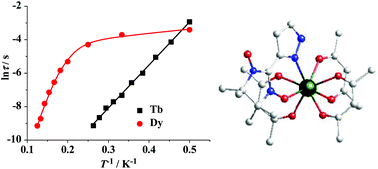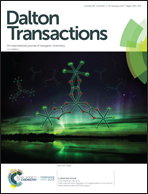Slow relaxation of the magnetization observed in mononuclear Ln–radical compounds with D4d geometry configurations†
Abstract
The combination of LnIII ions (GdIII, TbIII or DyIII) and a pyrazole nitronyl nitroxide radical results in three isomorphous complexes, namely, [Ln(hfac)3(NIT-Pyz)]2 (Ln = Gd(1), Tb(2), Dy(3); hfac = hexafluoroacetylacetone; NIT-Pyz = 2-{3-pyrazolyl}-4,4,5,5-tetramethylimidazoline-1-oxyl-3-oxide). Single crystal X-ray diffraction studies revealed that all of them are composed of two crystallographically independent mononuclear systems, in which the central LnIII ions are coordinated by three hfac and one bidentate chelating NIT-Pyz radical. The central LnIII ions are all in square antiprism geometry (D4d) polyhedron configurations. Based on the spin Hamiltonian calculations, there exist antiferromagnetic couplings in the GdIII-NIT radical system in complex 1. Complexes 2 and 3 show frequency-dependent out-of-phase signals in a zero field indicating single-molecule magnetic behavior. Moreover, Tb's complex (2) shows a single thermal relaxation process with an energy barrier of 26 K. For Dy's complex (3), the Orbach and Raman processes both contribute to the magnetic relaxation behaviors.



 Please wait while we load your content...
Please wait while we load your content...